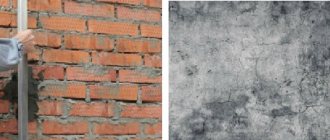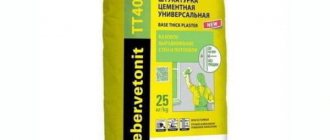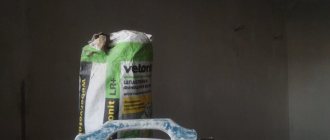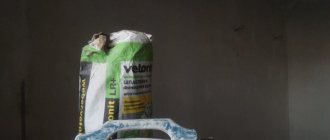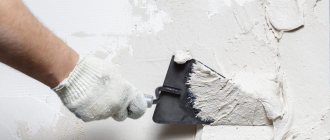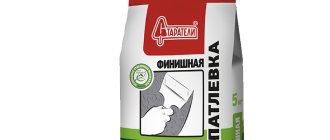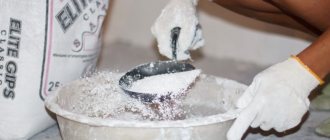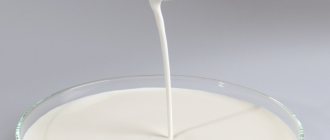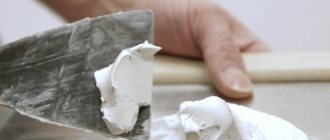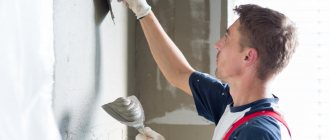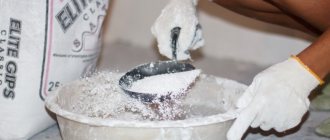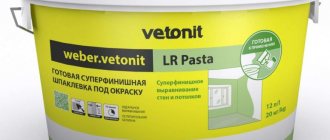The final stage of preparing the base for finishing is finishing putty, then it will be possible to paint or hang wallpaper without fear that even minor defects will be noticeable through the thin coating. It is required to carry out the work with a high-quality composition that can create a flawlessly leveled surface. Among the variety of compositions, KR putty from the Weber Vetonit company stands out. The special properties of the product and the rules for applying the solution to the base will be discussed in detail below.
Technical characteristics of Vetonit KR
- White color;
- The binder is organic glue;
- Mixture consumption, kg/m2/mm – 1.2;
- Water consumption, l/kg - 0.36-0.4 l/kg l/20 kg bag - 7.2-8.0 l/kg;
- Maximum fraction, mm - 0.3;
- Recommended application thickness, mm - 1-3mm;
- Recommended layer thickness (one application), mm - 1-3;
- Time of use from the moment of mixing with water (when stored in a closed container), day - 1(2);
- Drying time of one layer, days - 1;
- Packing - Three-layer paper bag with a middle layer of polyethylene 20 kg and a plastic bag 5 kg;
- Storage - 18 months from the date of manufacture, provided that it is stored in original packaging in a dry place.
LKMFLOT
Code: 100992623
Category:
Putties and Plasters
Brand:
Weber-vetonit
Packing:
5, 20
Packing:
1
Finishing putty Weber Vetonit KR (Weber Vetonit KR)
DESCRIPTION: Finishing putty with an organic binder for finishing walls and ceilings in dry rooms
PROPERTIES: - for dry rooms - finishing putty for painting and wallpapering - layer thickness 1-3mm - white surface - application both manually and mechanically
PURPOSE: Leveling walls and ceilings in dry interior rooms before: - wallpapering, - painting.
ADVANTAGES: Used on all types of smooth surfaces made of mineral materials (pre-leveled with weber.vetonit TTT, TT, T, L, V, VH, LR PLUS putties or plasters), plasterboard boards and painted surfaces, provided weber is added to the mixing water. Vetonit MD16.
PREPARATION OF THE BASE: The base must be solid, clean, free from dust and dirt. Substances that weaken adhesion such as grease, dust, etc. must be removed. The base must be dry. Excess moisture in the structure can cause yellowing of the leveled surface. Windows and other untreated surfaces must be carefully protected.
PREPARATION OF THE MIXTURE: Pour approx. 10.0 liters of clean water and add 25 kg (bag) of weber.vetonit KR mixture, and the mixture must be added to the water, and not vice versa. Recommended water temperature is 20°C. Mixing is done with a powerful drill with an attachment for 3-5 minutes. To better dissolve the binder, the mixture is allowed to stand for 15 minutes. After light re-stirring, the mixture is ready for use. The mortar mixture is suitable for use within 24 hours from the moment of mixing with water. The temperature of the mortar mixture must be at least +10°C. Unused mortar mixture should not be left in the mixing container, hoses, etc. for more than 1 day (for example, on weekends).
APPLICATION: The mortar mixture is applied by mechanical spraying or manually and leveled using a two-handed steel spatula. For partial leveling, use a smaller steel spatula 30cm wide. When leveling in several layers, it is necessary to apply each subsequent layer on the completely dry previous one. The dried surface of the putty must be treated with sanding paper and removed from dust before applying the next layer. After sanding, the leveled and dry surface can be painted or wallpapered according to the instructions of the manufacturer of these materials. To increase the wear resistance of the material and improve adhesion, you can replace 10% of the mixing water with weber.vetonit MD16. The weber.vetonit Md16 primer must be applied in the specified manner when applying putty to painted surfaces.
DRYING TIME: Drying time for one layer of recommended thickness at +10°C is approximately 2 days, at +20°C approx. 1 day, with good ventilation. Drying time depends on layer thickness, ventilation and temperature.
TECHNICAL CHARACTERISTICS: Color White Binder organic glue Limestone filler Maximum fraction, mm 0.3 Mixture consumption kg/m2/mm 1.2 Water consumption, l/kg 0.4 Water consumption, l/25 kg bag 10 Recommended layer thickness (one application), mm 1-3 Time of use from the moment of mixing with water, h 24 Drying time (one layer), days 1 Adhesion strength to concrete after 28 days, MPa, not less than 0.5
CLEANING OF TOOLS: Working tools and equipment are washed with water immediately after completion of work.
PRECAUTIONARY MEASURES: When working, you must use rubber gloves, avoid contact with skin and eyes, in case of contact with eyes, rinse with plenty of water, keep away from children.
DISPOSAL INSTRUCTIONS Dry mixture and hardened material must be disposed of as construction waste. The material must not be discharged into the sewer. Dispose of the paper bag as regular waste.
PACKING: Paper bag 25 and 5 kg
STORAGE: 18 months from the date of manufacture, provided that it is stored in original packaging in a dry place.
Instructions for use Vetonit KR
Preparing the base
The base must be clean, hard and durable. Windows and other untreated surfaces must be carefully protected. Substances that weaken adhesion such as grease, dust, etc. must be removed.
Preparing the mixture
Gradually pour a bag of Vetonit KR (25 kg) of dry mixture into a container with 10 liters of water, stirring at the same time.
Recommended water temperature + 20C. Mixing is carried out using a drill with an attachment for 3-5 minutes. Let the solution sit for 10 minutes. After this, stir the mixture again before use. The mixture is suitable for use 1 day after mixing with water.
Application
Apply the mixture manually using a steel spatula or spray it mechanically. The previous layer of putty must dry before applying the next layer. Grind the working seams and surface after sufficient drying after 1 day. The hardened mixture is ready for painting or wallpapering.
Application area
Vetonit KR putty is used for finishing leveling of ceilings and walls in rooms with dry and normal humidity conditions. It is applied to previously puttyed (vetonit T or B) or primed (vetonit TT) surfaces. Finishing vetonite can be applied for further painting or wallpapering (glass wallpaper). The putty cannot be used as a self-leveling mixture, a mortar for laying ceramic tiles, for sealing joints between gypsum boards, or in rooms with a relative air humidity of more than 70% (for example, bathrooms or saunas).
Concrete contact primer: features and consumption per 1m2
A primer is a unique solution that is used to prepare a specific surface for finishing, such as painting. The use of such a building mixture allows you to level the surface, get rid of any defects on the wall and eliminate small cracks.
One of the most popular types of primer is concrete contact, the use of which greatly simplifies further finishing work.
Main characteristics and properties
Concrete contact is a building mixture based on acrylic, which also includes cement, sand and special additives. This mixture is actively used to increase the adhesion of surfaces that do not absorb moisture well, before plastering, laying tiles and carrying out other finishing work.
Among its main advantages are the following:
- high drying speed. Further finishing work can begin a few hours after applying the primer;
- resistance to moisture. During the drying process, a special film is formed that does not allow water to pass through;
- durability. According to the manufacturing company, the concrete contact primer does not lose its qualities for 80 years.
Thanks to its unsurpassed properties, concrete contact has established itself as a unique material that is durable, does not require a lot of drying time and does not allow moisture to pass through. It is these properties that allow you not to worry about the quality of the repairs done.
How to determine the consumption of concrete contact?
The consumption of concrete contact per 1 m2 depends on many factors, among which the first place is occupied by the characteristics of the treated surface
It is not the type of surface itself that is important, but the porosity. It determines how much primer will be absorbed, which has a direct impact on its consumption per m2
Consumption table for concrete contact primer from different manufacturers
Depending on the porosity, the following types of surfaces are distinguished:
- Porous surfaces, which include brick or sand concrete. The primer is absorbed quite intensively, which leads to consumption of concrete contact up to 0.5 kg per m2. If the porosity is too large, then you will first need to treat the surface using special solutions.
- Surfaces with medium porosity. These include concrete and concrete tiles. Concrete contact consumption is about 0.3 kg per m2.
- Low-porous surfaces for which primer consumption is minimal - 0.1-0.2 kg per m2.
Purpose and features
Concrete contact is an acrylic adhesion additive based on quartz particles, which can be used to create rough surfaces. An important property of the composition is increased moisture permeability.
Depending on the scope of application of the BC there are:
- Under putty.
- For plastering.
The list of concrete contact features is as follows:
- The material is suitable for processing vertical and horizontal structures and promotes improved adhesion of building materials.
- BC is water resistant because it creates a special film on surfaces. Due to this property, it is used as a waterproofing agent when installing floor coverings.
- The drying time of the additive varies from 4 to 6 hours and is determined by the ambient temperature and humidity. If the humidity is high, you will have to wait at least a day before starting the next stage. A similar requirement should be followed when carrying out external work.
- Long service life. Experts say that if the application rules are followed, BC will be able to maintain its performance characteristics for 80 years.
- Working with factory compounds is quite simple. To apply them, you can use a roller, brush or other construction equipment. Due to its workability, the primer is suitable for both experienced builders and beginners.
The concrete contact contains the following components:
- Acrylic dispersion. Provides a key adhesion additive.
- Quartz sand. Designed to create rough surfaces.
- Cement composition.
- Chemical modifiers that contribute to properties such as hygroscopicity, environmental resistance and strength. Due to the absence of harmful additives, BC is an environmentally friendly material.
Concrete contact is rich in bactericidal elements that fight mold, fungal microorganisms and insects on treated surfaces. The material is characterized by neutral acidity, so it eliminates the possibility of a negative reaction with lime solutions or corrosive processes. Coloring pigments can also be added to the composition for more convenient application.
When figuring out how to apply concrete contact under tiles or gypsum plaster, you should carefully study all its properties and shelf life. They must be indicated on the packaging or in official documentation.
Advantages and disadvantages of floor leveling material
The leveling mixture can be considered an exclusive material. If we analyze the reviews of builders, the subject of our conversation has practically no shortcomings. However, completely ideal dry mixtures do not exist in nature. The problem is that the shortcomings appear after the solution is applied.
The undeniable advantages are:
- Ease of use - the work can be done on your own, without resorting to the services of professional builders.
- Fast setting – significantly reduces repair time.
- High leveling properties - you can level out the shortcomings of even the most problematic base.
- High resistance to dynamic loads - the floor can withstand the pressure of even office chairs.
The advantages include an affordable price.
The obvious disadvantages are:
- Low viability of the solution - difficulties arise when leveling floors in large areas.
- Dependence on the amount of water - failure to comply with the recommended proportions will lead to separation of the mixture.
Of course, the floor leveler must have excellent plasticity, but exceeding the amount of water will invariably lead to a loss of strength of the leveling layer. Violation of the solution preparation technology is the most common mistake of professional builders and beginners.
